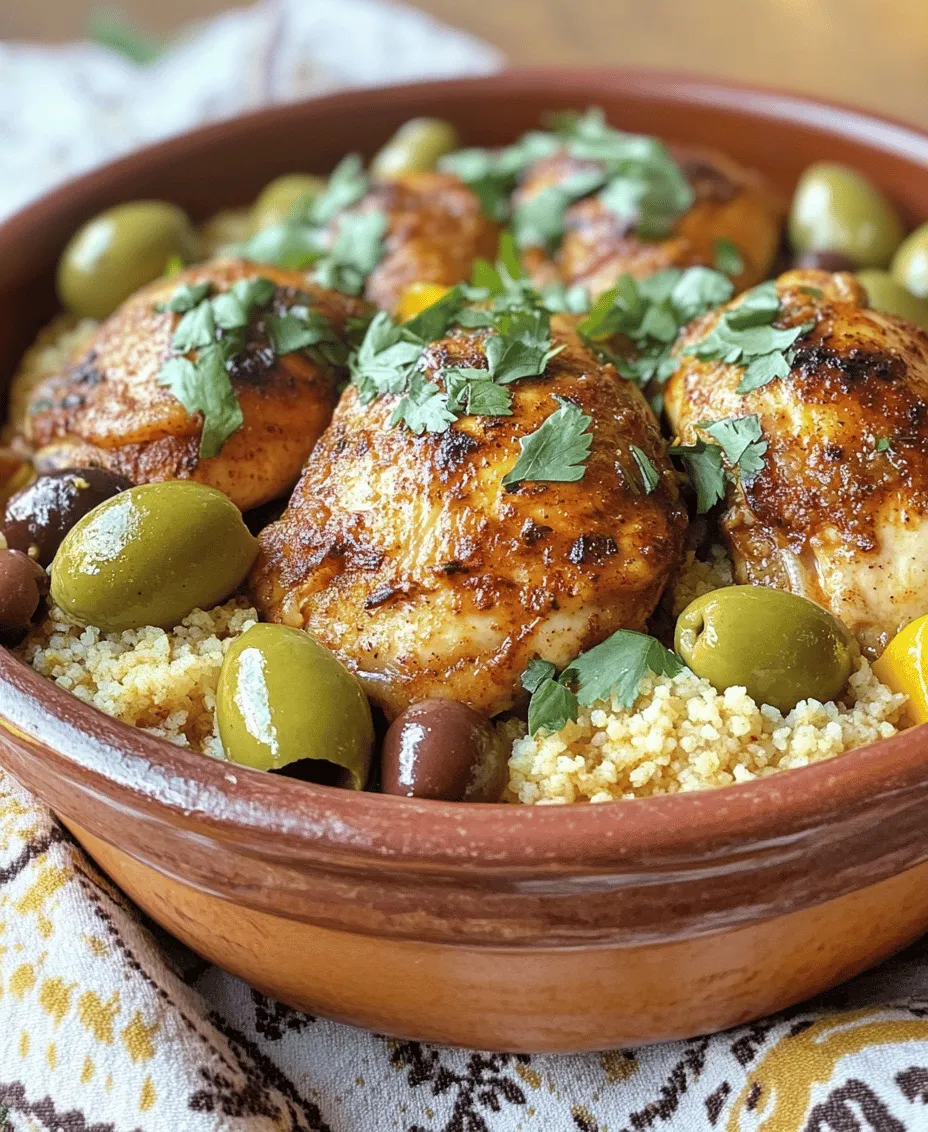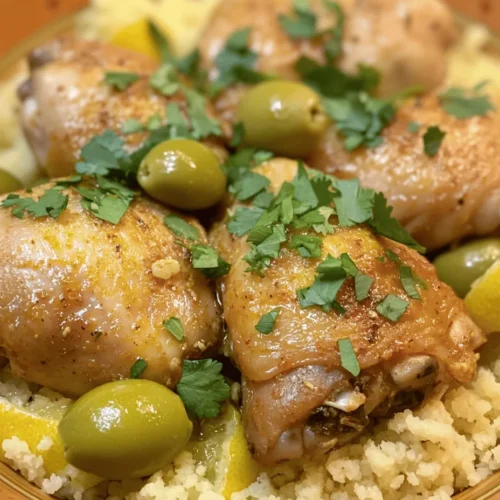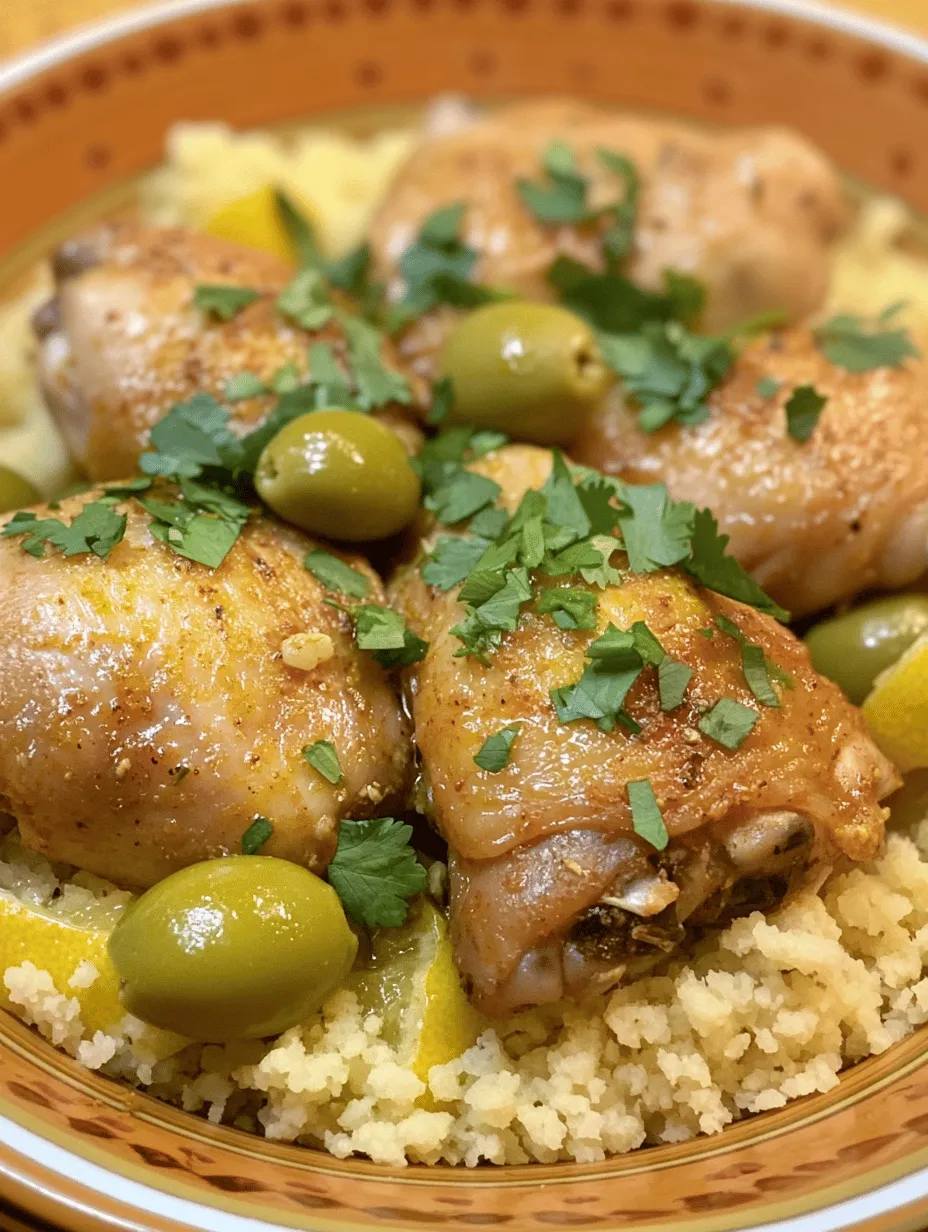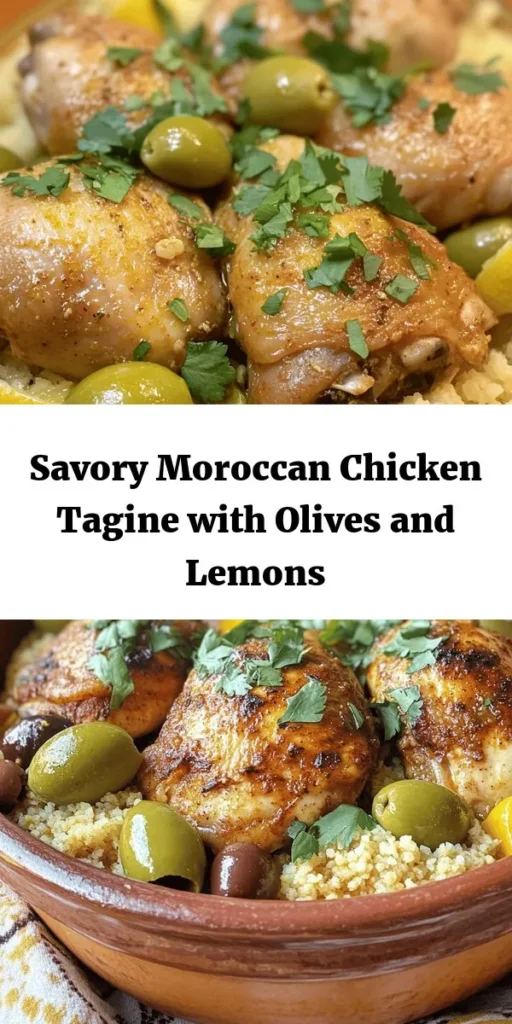Introduction
Moroccan cuisine is a tantalizing tapestry of flavors, colors, and aromas that reflects the diverse cultural influences that have shaped the region over centuries. This North African culinary tradition is renowned for its use of fragrant spices, fresh herbs, and vibrant ingredients, culminating in dishes that are as visually stunning as they are delicious. Among the many treasures of Moroccan cooking, one dish stands out for its rich flavors and comforting warmth: Moroccan Chicken Tagine with Olives and Preserved Lemons.
This iconic dish is a staple of Moroccan households, celebrated for its harmonious blend of savory, tangy, and aromatic characteristics. At its core, Moroccan Chicken Tagine features tender chicken pieces slow-cooked with a medley of spices, olives, and the distinct zing of preserved lemons, all brought together in a traditional tagine pot. The result is a culinary experience that transports you to the bustling markets of Marrakech with each bite.
To achieve an authentic Moroccan Chicken Tagine, it’s essential to use quality ingredients that capture the essence of this vibrant cuisine. From the chicken to the spices and olives, every component plays a crucial role in creating a dish that is not only flavorful but also representative of Moroccan culture. In this article, we will delve into the fascinating world of tagine cooking, explore the key ingredients that make this dish so special, and provide you with a step-by-step guide to preparing your own Moroccan Chicken Tagine right in your kitchen.
Understanding Tagine Cooking
At the heart of this iconic dish is the tagine itself—a traditional North African cooking vessel made from clay or ceramic. The tagine consists of two parts: a shallow circular base and a conical lid. This unique design serves several purposes that enrich the cooking process and enhance the final dish.
Firstly, the conical lid allows steam to circulate within the pot, creating a self-basting effect that keeps the chicken moist and tender while intensifying the flavors of the other ingredients. This slow cooking method results in a dish that is both juicy and packed with layers of taste. The tagine also provides gentle, even heat, which is perfect for simmering and slow-cooking, allowing the spices to meld beautifully and the aromatics to develop fully.
In Moroccan culture, tagine cooking is a communal experience, often shared among family and friends. It embodies the spirit of hospitality and togetherness, as meals are typically served directly from the tagine, allowing everyone to enjoy the culinary creation in a relaxed and inviting atmosphere. Cooking in a tagine not only enhances the flavors but also connects you to the rich cultural heritage of Morocco, making it a rewarding and authentic experience.
While you can replicate the essence of tagine cooking using a Dutch oven or a slow cooker, the unique properties of a tagine pot provide an unparalleled depth of flavor that is difficult to achieve through other methods. The slow, gentle cooking process allows the spices to infuse into the chicken, creating a tender and aromatic dish that speaks to the heart of Moroccan cuisine.
Key Ingredients in Moroccan Chicken Tagine
The success of Moroccan Chicken Tagine lies in the careful selection of its ingredients. Each component contributes to the depth of flavor and authenticity of the dish. Here are the key ingredients you’ll need to create this delightful dish:
Chicken Thighs
For an authentic Moroccan Chicken Tagine, chicken thighs are the preferred choice. Bone-in, skin-on thighs offer a richer flavor and are more forgiving during the slow-cooking process, ensuring they remain juicy and flavorful. The bones impart additional depth to the sauce, while the skin helps to create a pleasant texture. If you’re looking for tender, succulent chicken, thighs are the way to go.
Olive Oil
In Moroccan and Mediterranean cooking, the quality of olive oil is paramount. Extra virgin olive oil is favored for its rich, fruity flavor and health benefits. It not only aids in sautéing the aromatics but also adds a layer of depth to the dish. Using high-quality olive oil ensures that the flavors of the tagine shine through, making it essential for achieving that authentic taste.
Aromatics
The backbone of any great dish lies in its aromatics. In Moroccan Chicken Tagine, onions and garlic take center stage. Onions add sweetness and depth, while garlic brings a pungent earthiness that elevates the overall flavor profile. Together, they create a fragrant base that enhances the taste of the chicken and the accompanying spices.
Spices
Moroccan cuisine is renowned for its vibrant spices, which are essential for creating the complex flavor profiles characteristic of the region. For this Chicken Tagine, you will need:
– Cumin: Known for its warm, earthy flavor, cumin is a staple in Moroccan dishes. It provides a subtle nuttiness that enhances the overall taste of the tagine.
– Coriander: With its bright and citrusy notes, coriander complements the other spices, adding freshness to the dish.
– Cinnamon: This spice adds warmth and sweetness, creating a beautiful balance against the savory elements of the tagine.
– Paprika: Whether you use sweet or smoked paprika, this spice contributes color and a mild sweetness to the dish, enhancing its visual appeal.
Each of these spices plays a crucial role in building the aroma and flavor profile of the dish, creating the signature Moroccan taste that you’ll come to love.
Saffron
Saffron, the world’s most expensive spice, is prized for its unique flavor and vibrant color. In Moroccan Chicken Tagine, a pinch of saffron can elevate the dish, imparting a delicate floral note and a rich golden hue. While it’s not mandatory, using saffron can take your tagine to the next level, showcasing the authenticity and complexity of Moroccan cuisine.
Preserved Lemons
One of the standout ingredients in Moroccan cooking, preserved lemons are a game-changer in terms of flavor. They are made by curing lemons in a mixture of salt and their own juices, resulting in a tender, tangy ingredient that adds brightness and complexity to dishes. The sharp, salty flavor of preserved lemons complements the spices and chicken beautifully, making them an essential component of this tagine.
Green Olives
Green olives contribute both taste and texture to the dish. Their briny flavor enhances the overall profile of the tagine, creating a delightful contrast to the sweetness of the onions and the richness of the chicken. When added towards the end of cooking, they retain their firmness, adding a satisfying bite to each serving.
Fresh Herbs
To finish off your Moroccan Chicken Tagine, a sprinkle of fresh herbs such as cilantro or parsley adds a refreshing touch. These herbs not only enhance the visual appeal of the dish but also provide a burst of freshness that balances the rich flavors of the tagine.
Step-by-Step Guide to Making Moroccan Chicken Tagine
Now that we’ve covered the essential ingredients that will bring your Moroccan Chicken Tagine to life, let’s dive into the step-by-step process of preparing this delectable dish. With a preparation time of approximately 20 minutes and a cooking time of around 1.5 hours, this tagine is not only flavorful but also manageable for home cooks of all skill levels.
Preparation
1. Gather Your Ingredients: Before you start cooking, ensure you have all your ingredients prepped and ready. This includes chopping the onions, mincing the garlic, and measuring out your spices. Having everything on hand will streamline the cooking process and make it more enjoyable.
2. Marinate the Chicken: For maximum flavor, marinate the chicken thighs in a mixture of olive oil, lemon juice, garlic, and your selected spices (cumin, coriander, cinnamon, paprika, and saffron) for at least 30 minutes or preferably overnight. This step allows the chicken to absorb the flavors, resulting in a more flavorful dish.
3. Prepare the Tagine: If you’re using a traditional tagine pot, let it soak in water for about 30 minutes before cooking. This helps prevent cracking during the cooking process. If you don’t have a tagine, a Dutch oven works just as well.
4. Sauté the Aromatics: In the tagine or Dutch oven, heat olive oil over medium heat. Add the chopped onions and sauté until they become translucent. This usually takes about 5-7 minutes. Then, add the minced garlic and sauté for an additional minute until fragrant.
5. Brown the Chicken: Increase the heat to medium-high and add the marinated chicken thighs to the pot, skin-side down. Allow them to brown for about 5 minutes on each side. This step creates a delicious crust and enhances the overall flavor of the tagine.
6. Add the Remaining Ingredients: Once the chicken is browned, add the chopped preserved lemons and green olives to the pot. Sprinkle in the remaining spices, and pour in enough water or chicken broth to cover the chicken halfway. Stir gently to combine.
7. Simmer the Tagine: Cover the tagine with the conical lid (or the Dutch oven with a lid) and reduce the heat to low. Allow the tagine to simmer for about 1 to 1.5 hours, or until the chicken is tender and fully cooked. Check occasionally, adding more liquid if necessary to prevent burning.
By following these steps, you’ll be well on your way to creating an authentic Moroccan Chicken Tagine with Olives and Preserved Lemons that is sure to impress your family and friends. The next section will delve into tips for achieving the best results and answer common questions about this beloved dish.

Detailed Instructions
Browning the Chicken: Importance of This Step for Flavor
To begin making your Moroccan Chicken Tagine, the first crucial step is browning the chicken. This technique not only adds a lovely golden color to the meat but also develops a rich, umami flavor that serves as the foundation for your dish. Use a heavy-bottomed pot or a tagine if you have one, and heat a couple of tablespoons of olive oil over medium-high heat.
Once the oil is shimmering, add the chicken pieces skin-side down, making sure not to overcrowd the pan. Browning should take about 4-5 minutes on each side. The goal is to achieve a deep, caramelized exterior that will lend depth to your final dish. After browning the chicken, remove it from the pot and set it aside on a plate. Don’t discard the drippings; they are packed with flavor and will be incorporated into the sauce later.
Sautéing Aromatics: How to Achieve the Right Texture and Fragrance
With the chicken set aside, it’s time to sauté the aromatics. Start by adding diced onions, minced garlic, and grated ginger to the pot, where the chicken was browned. Sauté them over medium heat for about 5-7 minutes, or until the onions become translucent and soft. This step is vital as it builds the flavor base for your tagine.
For an added depth of flavor, consider adding chopped fresh cilantro and parsley at this stage. These herbs will infuse the dish with a fresh, aromatic quality that complements the spices beautifully. Stir frequently to prevent burning, ensuring that the ingredients meld and release their fragrances into the air.
Toasting Spices: Techniques for Maximizing Flavor
Next, it’s time to incorporate the spices that truly define Moroccan cuisine. In a separate small pan, lightly toast the spices before adding them to your tagine. This technique enhances their flavors, making them more potent. Use a combination of ground cumin, coriander, turmeric, cinnamon, and a pinch of cayenne pepper for a subtle kick.
Toast them over low heat for about 2-3 minutes, shaking the pan occasionally to prevent burning. Once fragrant, add the toasted spices directly to the sautéed aromatics in your pot. This technique allows the spices to release their essential oils, enriching the overall flavor profile of the dish.
Simmering: Importance of Low Heat and Patience in Cooking
After adding the browned chicken back to the pot, pour in enough chicken stock or water to cover the chicken halfway. Bring the mixture to a gentle simmer and cover the pot with a lid. The key to a perfect tagine is low-and-slow cooking. Reduce the heat to low, allowing the chicken to simmer for at least 45 minutes to 1 hour.
During this time, the chicken will absorb all the flavors from the spices and aromatics, becoming tender and juicy. The low heat ensures that the meat cooks evenly without drying out. If using a traditional tagine, ensure it is placed on a heat diffuser to prevent direct contact with the flame.
Incorporating Preserved Lemons and Olives: Timing for Best Flavor Integration
About 15 minutes before serving, add the star ingredients—preserved lemons and olives. Slice the preserved lemons into wedges, discarding any seeds, and add them to the pot along with a handful of green or black olives, according to your preference. The preserved lemons impart a unique tanginess that brightens the dish, while the olives add a savory depth.
Allow the tagine to continue simmering uncovered for the remaining time. This lets the flavors meld together beautifully. The briny olives and zesty lemons will infuse the sauce, creating a vibrant and aromatic dish that is characteristic of Moroccan cuisine.
Serving Suggestions: Tips on Plating and Presentation
To serve your Moroccan Chicken Tagine, start by spooning the chicken and sauce into a shallow serving dish. For an authentic touch, sprinkle with fresh chopped cilantro and parsley for a burst of color. Serve alongside fluffy couscous or rice, which will soak up the flavorful sauce beautifully.
Consider presenting the dish in a traditional tagine pot for a rustic appearance. This not only maintains the dish’s warmth but also adds to the overall aesthetic. You can also serve it with warm pita bread or Moroccan flatbreads, perfect for scooping up the delectable sauce.
Flavor Profile and Cooking Techniques
The beauty of Moroccan Chicken Tagine lies in its intricate flavor profile. The combination of spices—sweet, savory, and slightly spicy—harmonizes beautifully during the cooking process. As the chicken simmers, the spices develop and deepen, creating a fragrant aroma that fills your kitchen.
Simmering at low heat not only tenderizes the chicken but also allows the flavors to meld and intensify. The science behind this slow cooking method is simple: the low temperature breaks down the connective tissues in the chicken, resulting in a moist and tender bite. After cooking, allow your tagine to rest for about 10 minutes; this resting time is crucial, as it lets the flavors meld even further, enhancing the overall taste experience.
Pairing Suggestions for Moroccan Chicken Tagine
When it comes to side dishes, Moroccan Chicken Tagine pairs wonderfully with fluffy couscous or steamed rice. Both options act as a perfect canvas for the rich sauce, allowing the flavors to shine through.
For a refreshing contrast, consider serving a simple salad made with mixed greens, cucumber, and tomatoes dressed with a light lemon vinaigrette. This will provide a nice crunch and acidity to balance the richness of the tagine.
Beverage pairings can enhance the dining experience as well. A light Moroccan white wine or a fruity rosé complements the spices without overpowering them. Alternatively, Moroccan mint tea is a traditional beverage that pairs beautifully with this dish, adding a refreshing finish to your meal.
Cultural Significance of Moroccan Cuisine
Moroccan cuisine is a tapestry of flavors influenced by various cultures, including Berber, Arab, and Mediterranean traditions. The use of spices and slow-cooking techniques has been passed down through generations, making dishes like Chicken Tagine a staple in Moroccan households.
Communal eating is a significant aspect of Moroccan culture, often symbolizing family and togetherness. Meals are typically shared from a single dish, encouraging conversation and connection among diners. This tradition is beautifully embodied in the serving of Chicken Tagine, as it invites everyone to gather around and enjoy the meal together.
This dish reflects the rich heritage and culinary traditions of Morocco, showcasing the vibrant flavors that characterize its cuisine. Each bite tells a story of the country’s history, making the experience of preparing and enjoying Moroccan Chicken Tagine even more meaningful.
Conclusion
In summary, Moroccan Chicken Tagine with olives and preserved lemons is a dish that encapsulates the essence of Moroccan cooking—rich, aromatic, and deeply flavorful. The combination of spices, the tender chicken, and the zesty preserved lemons create a meal that is both satisfying and memorable.
As you explore this recipe, you not only discover the joy of preparing a traditional Moroccan dish but also gain insight into the cultural significance behind it. We encourage you to dive deeper into Moroccan cuisine, appreciating the layers of flavor and history present in each recipe. Enjoy your culinary journey, and may your Moroccan Chicken Tagine be a delightful experience that brings warmth to your table and joy to your heart.



